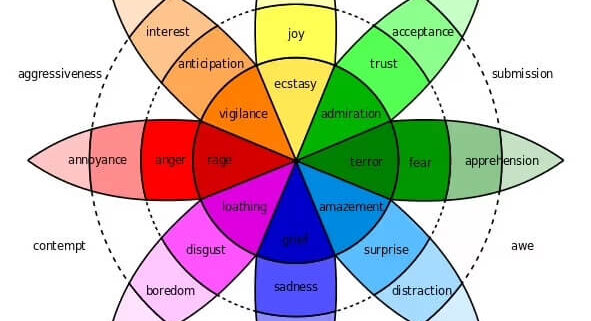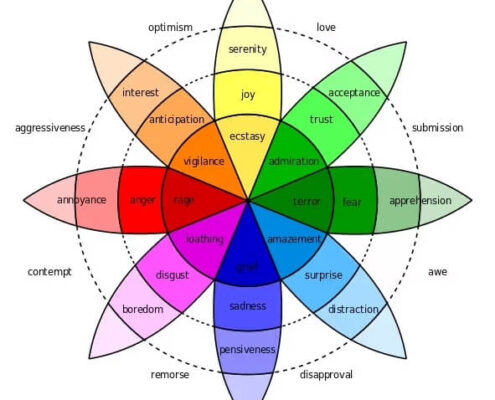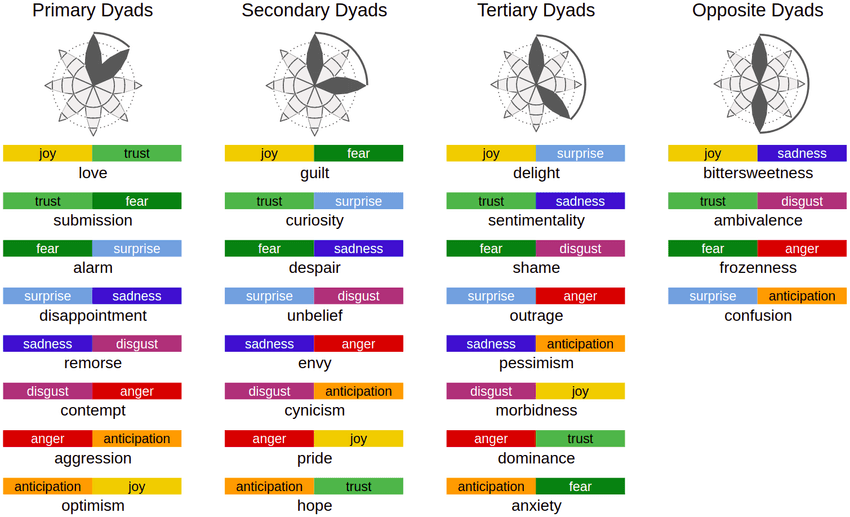How we blend emotions
Humans are incredibly complex emotional beings. We experience a vast range of emotions beyond the core/basic emotions. These emotions don’t exist in isolation—our minds and bodies constantly process and combine them, creating rich internal experiences that shape our thoughts, behaviors, and interactions with the world. The feedback loop between emotions and cognition allows us to reinterpret and reshape how we feel.
Table of Contents
- Plutchik’s Emotion Wheel
- Dyad Emotions
- The 24 Plutchik Dyads
- How to Use This New Understanding
- The Anxiety Dyad
Interestingly, emotions are not only stored and processed in the brain. Neuroscientific research confirms that emotions manifest physically in multiple ways. Stress, for example, often tightens muscles in the shoulders, neck, and back. When we consciously relax those muscles through deep breathing or movement, we can reduce stress levels by disrupting that physical-emotional feedback loop (source Breathing Practices for Stress and Anxiety Reduction: Conceptual Framework of Implementation Guidelines Based on a Systematic Review of the Published Literature, 2023). Furthermore, the gut plays a major role in emotional processing. Our intestines house an extensive neural network called the enteric nervous system, sometimes referred to as the “second brain” because of its dense concentration of neurons and neurotransmitters (Gershon, 1998). This explains why we experience “gut feelings”—scientifically, our intestines communicate directly with the brain via the vagus nerve.
With this in mind, let’s explore compound emotions (dyads) and how they provide a deeper understanding of our emotional lives.
Plutchik’s Emotion Wheel
Psychologist Robert Plutchik developed the Emotion Wheel as a model to categorize emotions and their intensities. His theory suggests:
- Core (Basic) Emotions: Joy, Trust, Fear, Surprise, Sadness, Disgust, Anger, and Anticipation.
- Milder Forms: Serenity, Acceptance, Apprehension, etc.
- Intense Forms: Ecstasy, Admiration, Terror, etc.
- Dyad Emotions: Combinations of core emotions that form new feelings (e.g., Joy + Trust = Love).
Dyad Emotions
Dyad emotions arise when two core emotions combine. Plutchik identified 24 dyads, each representing a unique blend of emotions. These combinations create entirely new feelings, such as:
- Joy + Trust = Love: The warmth of joy coupled with the safety of trust.
- Fear + Surprise = Awe: The overwhelming sensation we get when something is both astonishing and intimidating.
- Anticipation + Fear = Anxiety: The distressing sensation of expecting something bad to happen.
The 24 Plutchik Dyads
Plutchik organized dyads into three levels: primary (adjacent emotions), secondary (one emotion apart), and tertiary (two emotions apart). This structure helps us understand how emotions build upon one another.
How to Use This New Understanding
Understanding how emotions interact can be incredibly useful. When you recognize that anxiety stems from anticipation and fear, you can break it down into manageable parts and address them individually.
The Anxiety Dyad
Anxiety = Anticipation + Fear
Anxiety is an emotional state rooted in both anticipation and fear. While fear signals immediate danger, anticipation projects that fear into the future, often leading to overthinking and worry.
Anticipation
Anticipation is the cognitive process of preparing for future events. It can be positive (excitement for a vacation) or negative (dreading an upcoming confrontation). When anticipation focuses on negative possibilities, it fuels anxiety.
Fear
Fear is a survival mechanism that helps us respond to threats. However, in the absence of an immediate danger, persistent fear can create chronic anxiety.
Managing Anxiety
To reduce anxiety, consider these approaches:
- Mindfulness: Ground yourself in the present moment instead of spiraling into future concerns.
- Cognitive Reframing: Challenge irrational fears by examining their likelihood.
- Physical Relaxation: Since emotions manifest physically, relaxation techniques like deep breathing help disrupt anxiety patterns.
By breaking down emotions into their core components, you can better understand and manage your feelings.
What the Professionals Say
Learn more about the fear of fear in the Anticipatory Anxiety post.
Learn more about Counseling for Anxiety in Austin.
Jonathan F. Anderson, LPC-s has worked in the helping profession since he started college in 1990. After completing his Bachelor’s degree at the University of Texas, Austin in 1994, he attended the highly-regarded University of Minnesota to earn his Master’s degree in 1997. He is a Licensed Professional Counselor and is recognized as a Board Approved Supervisor by the State of Texas Board of Examiners of Professional Counselors. Jonathan has completed Level 2 of the Gottman Method of Couples Counseling, and in 1998 received training from the International Critical Incident Stress Foundation in Advanced Critical Incident Stress Management & Debriefing. To learn more about Jonathan’s practice, click here: Jonathan F. Anderson, LPC-s.




